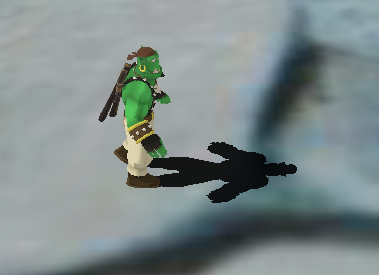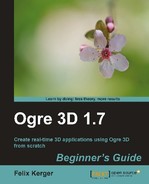Our model can move but it isn't animated yet, let's change this.
- The
FrameListenerneeds two animation states:Ogre::AnimationState* _aniState; Ogre::AnimationState* _aniStateTop;
- To get the animation states in the constructor, we need a pointer to the entity:
MyFrameListener(Ogre::RenderWindow* win,Ogre::Camera* cam,Ogre::Viewport* viewport,Ogre::SceneNode* node,Ogre::Entity* ent)
- With this pointer we can retrieve the
AnimationStateand save them for later use:_aniState = ent->getAnimationState("RunBase"); _aniState->setLoop(false); _aniStateTop = ent->getAnimationState(«RunTop»); _aniStateTop->setLoop(false); - Now that we have the
AnimationState, we need to have a flag in theframeStartedfunction, which tells us whether or not the entity walked this frame. We add this flag into theifconditions that query the keyboard state:bool walked = false; if(_Keyboard->isKeyDown(OIS::KC_UP)) { SinbadTranslate += Ogre::Vector3(0,0,-1); _rotation = 3.14f; walked = true; } if(_Keyboard->isKeyDown(OIS::KC_DOWN)) { SinbadTranslate += Ogre::Vector3(0,0,1); _rotation = 0.0f; walked = true; } if(_Keyboard->isKeyDown(OIS::KC_LEFT)) { SinbadTranslate += Ogre::Vector3(-1,0,0); _rotation = -1.57f; walked = true; } if(_Keyboard->isKeyDown(OIS::KC_RIGHT)) { SinbadTranslate += Ogre::Vector3(1,0,0); _rotation = 1.57f; walked = true; } - If the model moves, we enable the animation; if the animation has ended, we loop it:
if(walked) { _aniState->setEnabled(true); _aniStateTop->setEnabled(true); if(_aniState->hasEnded()) { _aniState->setTimePosition(0.0f); } if(_aniStateTop->hasEnded()) { _aniStateTop->setTimePosition(0.0f); } } - If the model didn't move, we disable the animation and set it to the start position:
else { _aniState->setTimePosition(0.0f); _aniState->setEnabled(false); _aniStateTop->setTimePosition(0.0f); _aniStateTop->setEnabled(false); } - In each frame, we need to add the passed time to the animation; otherwise, it wouldn't move:
_aniState->addTime(evt.timeSinceLastFrame); _aniStateTop->addTime(evt.timeSinceLastFrame);
- The application now also needs a pointer to the entity:
Ogre::Entity* _SinbadEnt;
- We use this pointer while instantiating the
FrameListener:_listener = new MyFrameListener(window,camera,viewport,_SinbadNode,_SinbadEnt);
- And, of course, while creating the entity:
_SinbadEnt = _sceneManager->createEntity("Sinbad.mesh"); - Compile and run the application. Now the model should be animated when it moves:

..................Content has been hidden....................
You can't read the all page of ebook, please click here login for view all page.
